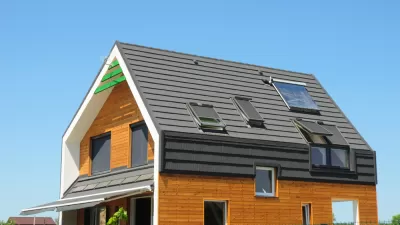The American Institute of Architects gave a reality check regarding its ambitious and aggressive carbon reductions targets.

"According to the 'AIA 2030 Commitment 2015 Progress Report,' [pdf] released today, the design industry is not on pace to meeting the ambitious goal of having every project designed by a signatory firm achieving carbon neutrality by 2030," according to an article by Wanda Lau.
In a separate post, Kim Slowey puts the findings of the progress report succinctly: "Only 4% of projects so far have met the 70% energy savings target for 2015 building performance, with the average savings coming in at 38%."
Although the building industry is falling short of the goals set forth in the 2030 Commitment, "All told, the energy predicted to be saved from the 2015 reported projects totals 21 million metric tons of greenhouse gas emissions," explains Lau. "According to the U.S. Environmental Protection Agency’s Greenhouse Gas Equivalencies Calculator, this is the equivalent of powering 2.2 million houses in a year." Participation and the total square footage of projects in the initiative have also increased since 2014.
As part of the article's in-depth coverage of the AIA's progress report, Lau includes an examination of the energy modeling that the report emphasizes for projects to meet "increasingly stringent benchmarks."
FULL STORY: A Reality Check from the AIA 2030 Commitment 2015 Progress Report

Alabama: Trump Terminates Settlements for Black Communities Harmed By Raw Sewage
Trump deemed the landmark civil rights agreement “illegal DEI and environmental justice policy.”

Planetizen Federal Action Tracker
A weekly monitor of how Trump’s orders and actions are impacting planners and planning in America.

How Atlanta Built 7,000 Housing Units in 3 Years
The city’s comprehensive, neighborhood-focused housing strategy focuses on identifying properties and land that can be repurposed for housing and encouraging development in underserved neighborhoods.

In Both Crashes and Crime, Public Transportation is Far Safer than Driving
Contrary to popular assumptions, public transportation has far lower crash and crime rates than automobile travel. For safer communities, improve and encourage transit travel.

Report: Zoning Reforms Should Complement Nashville’s Ambitious Transit Plan
Without reform, restrictive zoning codes will limit the impact of the city’s planned transit expansion and could exclude some of the residents who depend on transit the most.

Judge Orders Release of Frozen IRA, IIJA Funding
The decision is a victory for environmental groups who charged that freezing funds for critical infrastructure and disaster response programs caused “real and irreparable harm” to communities.
Urban Design for Planners 1: Software Tools
This six-course series explores essential urban design concepts using open source software and equips planners with the tools they need to participate fully in the urban design process.
Planning for Universal Design
Learn the tools for implementing Universal Design in planning regulations.
Caltrans
Smith Gee Studio
Institute for Housing and Urban Development Studies (IHS)
City of Grandview
Harvard GSD Executive Education
Toledo-Lucas County Plan Commissions
Salt Lake City
NYU Wagner Graduate School of Public Service





























